Cyber-Physical Threat Intelligence for Critical Infrastructures Security: A Guide to Integrated Cyber-Physical Protection of Modern Critical Infrastructures

Edited by John Soldatos, University of Glasgow and INNOV-ACTS LIMITED, UK | James Philpot, European Organization for Security, UK | Gabriele Giunta, Engineering Ingegneria Informatica S.p.A., Italy
Publication Date: 17 Sep 2020
Suggested Citation: John Soldatos (ed.), James Philpot (ed.), Gabriele Giunta (ed.) (2020), "Cyber-Physical Threat Intelligence for Critical Infrastructures Security: A Guide to Integrated Cyber-Physical Protection of Modern Critical Infrastructures", Boston-Delft: now publishers, http://dx.doi.org/10.1561/9781680836875
Downloaded: 126019 times
Description
Modern critical infrastructures comprise of many interconnected cyber and physical assets, and as such can be considered as large scale cyber-physical systems. Hence, the conventional approach of addressing cyber security and physical security separately is no longer effective. Rather more integrated approaches that address the security of cyber and physical assets at the same time are required. This book presents integrated (i.e. cyber and physical) security approaches and technologies for some of the most important infrastructures that underpin our societies. Specifically, it introduces advanced techniques for threat detection, risk assessment and security information sharing, based on leading edge technologies like machine learning, security knowledge modeling, IoT security and distributed ledger infrastructures. Likewise, it presets how established security technologies like SIEM, pen-testing, vulnerability assessment and security data analytics can be used in the context of integrated Critical Infrastructure Protection.
The novel methods and techniques of the book are exemplified in case studies involving critical infrastructures in four industrial sectors, namely finance, healthcare, energy and communications. The peculiarities of critical infrastructure protection in each one of these sectors is discussed and addressed based on sector-specific solutions.
The advent of the fourth industrial revolution (Industry 4.0) is expected to increase the cyber-physical nature of critical infrastructures as well as their interconnection in the scope of sectorial and cross-sector value chains. Therefore, the demand for solutions that foster the interplay between cyber and physical security, and enable Cyber-Physical Threat Intelligence is likely to explode. In this book we have shed light on the structure of such integrated security systems, as well as on the technologies that will underpin their operation. We hope that Security and Critical Infrastructure Protection stakeholders will find the book useful when planning their future security strategies.
-
ISBN: 978-1-68083-687-5
450 pp. Open Access (.pdf) This is published under the terms of CC BY-NC
